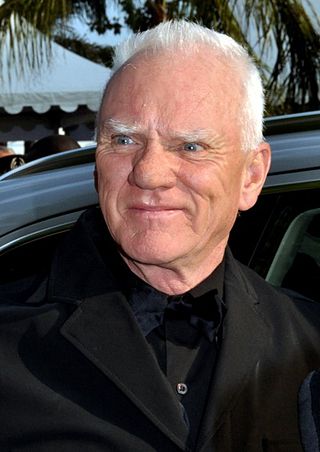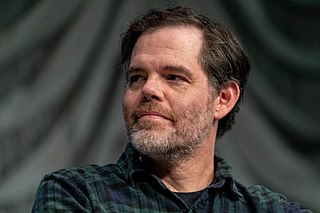
Malcolm McDowell is an English actor. He is known for portraying Alex DeLarge in A Clockwork Orange (1971) and the title character in the "Mick Travis trilogy" (1968–1982). McDowell is the recipient of an Evening Standard British Film Award, alongside nominations for Golden Globe and Screen Actors Guild Awards. He received a star on the Hollywood Walk of Fame in 2012.

Wesley Wales Anderson is an American filmmaker. His films are known for their eccentricity, unique visual and narrative styles, and frequent use of ensemble casts. They often contain themes of grief, loss of innocence, and dysfunctional families. Some critics cite Anderson as a modern-day example of an auteur. Three of his films have appeared in BBC Culture's 2016 poll of the greatest films since 2000.
The University of Southern California School of Cinematic Arts (SCA) houses seven academic divisions: Film & Television Production; Cinema & Media Studies; John C. Hench Division of Animation + Digital Arts; John Wells Division of Writing for Screen & Television; Interactive Media & Games; Media Arts + Practice; Peter Stark Producing Program.
The University of Southern California's School of Cinematic Arts's Interactive Media & Games Division first accepted M.F.A. students in 2002. The division currently offers both undergraduate (B.F.A.) and graduate programs in interactive media and game design, as well as B.F.A. programs in game art and themed entertainment and an M.A. in media, games and health. The programs include courses in game design, game development, production, audio, animation, and user research as well as experimental work in gestural and immersive interfaces, transmedia design, and interactive cinema.

A Clockwork Orange is a 1971 dystopian crime film adapted, produced, and directed by Stanley Kubrick, based on Anthony Burgess's 1962 novel of the same name. It employs disturbing, violent images to comment on psychiatry, juvenile delinquency, youth gangs, and other social, political, and economic subjects in a dystopian near-future Britain.

Full Sail, LLC, doing business as Full Sail University, is a private for-profit university in Winter Park, Florida. It was formerly a recording studio in Ohio named Full Sail Productions and Full Sail Center for the Recording Arts. The school moved to Florida in 1980 and began offering online degrees in 2007.

Mark Bolas is a researcher exploring perception, agency, and intelligence. He is a Professor of Interactive Media in the USC Interactive Media Division, USC School of Cinematic Arts at the University of Southern California, Director of their Interactive Narrative and Immersive Technologies Lab, Director of Mixed Reality Laboratory at USC's Institute for Creative Technologies, and chairman of Fakespace Labs in Mountain View, California. Bolas is currently on leave from USC, working on the Hololens team at Microsoft.
Worldbuilding is the process of constructing a world, originally an imaginary one, sometimes associated with a fictional universe. Developing an imaginary setting with coherent qualities such as a history, geography, and ecology is a key task for many science fiction or fantasy writers. Worldbuilding often involves the creation of geography, a backstory, flora, fauna, inhabitants, technology and often if writing speculative fiction, different peoples. This may include social customs as well as invented languages for the world.

Lance Weiler is an American filmmaker and writer from Pennsylvania, and the Director of the Digital Storytelling Lab at Columbia University School of the Arts. He first was known for The Last Broadcast (1997), a found footage horror film which he co-wrote, co-produced, co-directed, and co-starred in with Stefan Avalos. The Last Broadcast made cinematic history on October 23, 1998 as the first all-digital release of motion picture to be stored and forwarded via geosynchronous satellite. Initially working as an assistant cameraman and camera operator on large commercial shoots, in Pennsylvania and later New York City, Weiler is known for increasing work in experimental combinations of film, AI, gaming, and related media.
David Blass is an American production designer and art director.

Tracy Fullerton is an American game designer, educator and writer, best known for Walden, a game (2017). She is a Professor in the USC Interactive Media & Games Division of the USC School of Cinematic Arts and Director of the Game Innovation Lab at USC.
Daniel Bilson is an American writer, director, and producer of movies, television, video games, and comic books. Together with his frequent collaborator, Paul De Meo, he is best known as the writer for the film The Rocketeer (1991) and creator, writer, producer and director for the television series Viper, The Sentinel (1996) and The Flash (1990). He has written multiple issues of the comic book The Flash, as well as scripts for multiple video games, including James Bond 007: Everything or Nothing (2003). Da 5 Bloods (2020), based on a screenplay written by Bilson & De Meo, was released following De Meo's death.

Immersive design describes design work which ranges in levels of interaction and leads users to be fully absorbed in an experience. This form of design involves the use of virtual reality (VR), augmented reality (AR), and mixed reality (MR) that creates the illusion that the user is physically interacting with a realistic digital atmosphere.
Created in 2013, Media Arts and Practice (MA+P) is the seventh degree-granting division of the USC School of Cinematic Arts.

François Audouy is a French-American movie production designer. He is a frequent collaborator with director James Mangold, having designed The Wolverine (2013) its sequel Logan (2016), and Ford v Ferrari (2019) which was nominated for several Academy Awards including Best Picture.
Jeff Watson was a Canadian game designer, writer, and educator. His principal topics of interest were pervasive and environmental game design, creative process design, and participatory media. He served as an assistant professor of interactive media and games at the USC School of Cinematic Arts, was an associate faculty member with the USC Game Innovation Lab, and directed the Situation Lab.

Karla Maria S. Rothstein is an American architect and adjunct Associate Professor at Columbia Graduate School of Architecture, Planning and Preservation, where she is also the founder and director of Columbia University's trans-disciplinary DeathLAB Rothstein is also the co-founder of Latent Productions, an architecture, research, and development firm in New York City, which she co-founded in 1999 with Salvatore Perry. A significant focus of her architecture practice, research, and teaching has been redefining urban spaces of death and remembrance.
Video game writing is the art and craft of writing scripts and narratives for video games. Similar to screenwriting, it is typically a freelance profession. It includes many differences from writing for film, due to the non-linear and interactive nature of most video games, and the necessity to work closely with video game designers and voice actors. There are many differing types of text in video games in comparison to stage shows or movies, including written text, foreign or made-up languages, and often situation-based information. Especially when developing Triple A games, more than one writer will be required to create the game, split into different roles.

Stuart Candy is an Australian futurist and designer. Candy is a Fellow of the World Futures Studies Federation, Museum of Tomorrow. He is the first Research Fellow of The Long Now Foundation. His work deals with futurism and designing experiential futures through immersive storytelling.
Joshua Ashish Dawson is a film director & designer based in Los Angeles, California.











